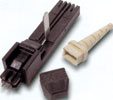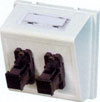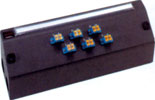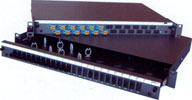
No matter the style, the small form factor fibre connector design lends itself to high-density presentation and well-organised fibre management. This type of connector has been available for some time now but we are only just seeing any significant usage in the past 12-18 months.
Suggestions have been that earlier economic conditions slowed its general introduction and pick-up. Back in 1998 the Standards bodies decided not to establish a single small form factor (SFF) connector for the optical fibre 'structured cabling system' industry but left it, in a sense, to the manufacturers and developers of the types available, to win market share and possibly fight it out. This meant the various manufacturers were left to convince the vendors of active equipment that a particular solution was best - then, maybe a winner would be shaken out.
With consideration of the time now passed, the debate still continues. Over this period of six years, the uptake and standard adoption of SFF connectors for optical fibre has not met expectations with realisation only evident in the past 12 months. Although there are at least six styles of SFF optical connectors available, two types have shown good market acceptance and are gaining recognition very quickly. These two types each have various pros and cons that may see each taking somewhat specific paths for application and usage.

MT-RJ
The MT-RJ provides two fibres within a single ferrule with the general feel and dimension of the copper eight-wire modular plug and jack assembly. Field termination is, in most cases, based on cleaving the fibre and mechanically splicing within the body of the connector to pre-polished and tested fibre stubs. This can result in very short duplex termination times. The MT-RJ enjoys quick and relatively fool-proof field termination, giving it a perceived advantage for the private network and LAN environment.

LC style
The LC style SFF connector is based on the traditional single fibre per ferrule, but is basically a half-size SC, therefore the duplex arrangement of the LC has a footprint similar in dimension to the MT-RJ. Termination of this connector also follows traditional methods, which results in longer finishing times. The LC has already made its presence felt in the Public Network showing proven directions with single mode fibre and the ability to provide a simplex connection if required. The LC connector offers very low insertion losses for both single and multimode fibre and exhibits good back-reflection properties. This is not to suggest that the LC has no place in the private domain and LAN environment; its excellent insertion loss properties and performance in particular with single-mode fibre, will ensure its place in the enterprise networks.
LC connector
Both types exhibit good mechanical properties and provide positive latching and ability to polarise the connection at the interface. The size and feel of the connector styles are something the end-user is familiar with. It is safe to state that the MT-RJ and the LC connectors are currently winning the race and are here for the long haul.

Others
There are the other types of SFF connectors, one or two that can be considered a more proprietary design, and one that engages the philosophy of a total end-to-end solution including active equipment for the client but they still have a level of exposure and use.

And still, we wait for the 'optical fibre to the desktop' promise to become a reality. It has been suggested that the SFF connector will allow FTTD applications to be more cost effective and there is no reason to doubt this. But even so, the copper juggernaut grinds continually on.
Other applications that the SFF connector has shown encouraging entrances are Fibre to the Kerb and Fibre to the Home. These two initiatives can be parcelled into the same 'wish-list' box as Fibre to the Desk and have been mooted even longer than the desktop solutions.
The article has focused on these two styles of SFF connector because both are available in the Molex Premise Networks portfolio of products and research shows market acceptance of these two types of connectors at a generic level.
For more information contact Datanet, +27 (0)11 990 6000.

© Technews Publishing (Pty) Ltd | All Rights Reserved